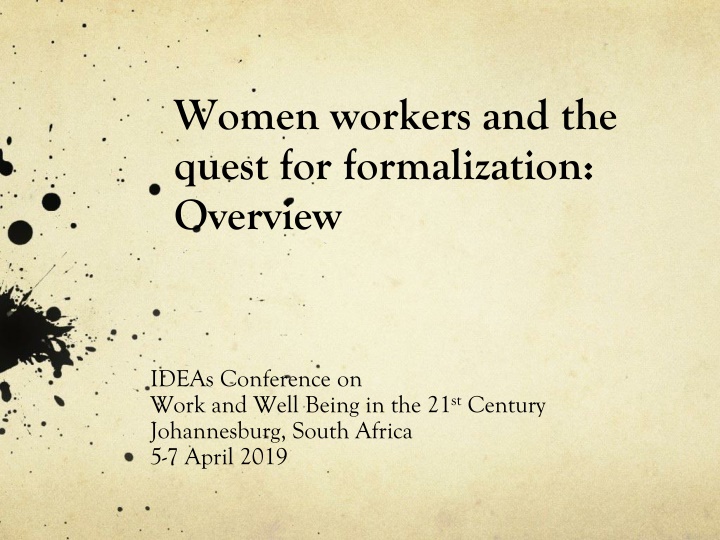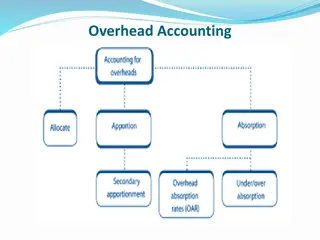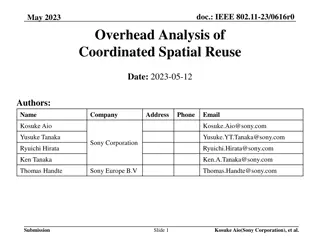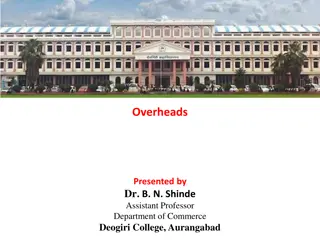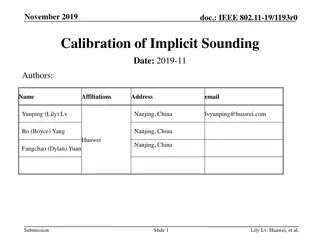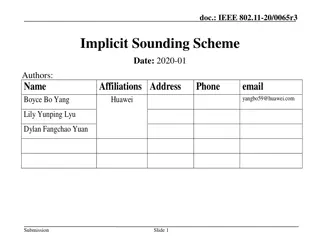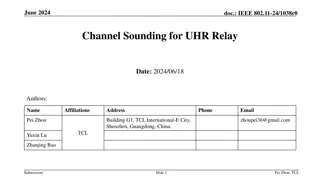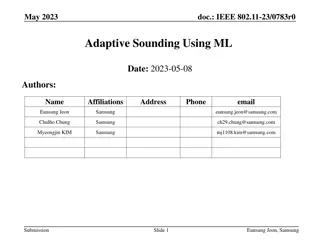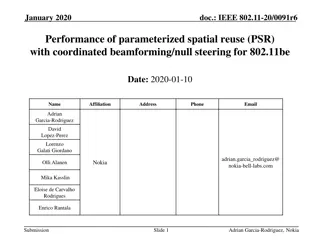IEEE 802.11-24/1582r2 Coordinated Sounding for CoBF: Sounding Sequences & Overhead Discussion
In this presentation from the September 2024 IEEE meeting, the coordinated sounding for CoBF is explored by discussing sounding sequences and their associated overhead. Different modes of sequential and joint sounding are detailed, including the addressing of BSS non-AP STAs and shared APs. The unified coordinated sounding scheme is presented, addressing similarities between different sounding sequences. Furthermore, the concept of NDP Global Index LTFs is introduced, along with a comparison of airtime requirements for sequential versus joint sounding scenarios based on specific antenna configurations.
Download Presentation

Please find below an Image/Link to download the presentation.
The content on the website is provided AS IS for your information and personal use only. It may not be sold, licensed, or shared on other websites without obtaining consent from the author.If you encounter any issues during the download, it is possible that the publisher has removed the file from their server.
You are allowed to download the files provided on this website for personal or commercial use, subject to the condition that they are used lawfully. All files are the property of their respective owners.
The content on the website is provided AS IS for your information and personal use only. It may not be sold, licensed, or shared on other websites without obtaining consent from the author.
E N D
Presentation Transcript
Women workers and the quest for formalization: Overview IDEAs Conference on Work and Well Being in the 21stCentury Johannesburg, South Africa 5-7 April 2019
What is the point of this study? Need to formalise informal economic activities and employment is obvious, if only to provide better workers protection. Women are more likely to be informal workers with lower wages and more precarious conditions. Policies for formalisation are therefore generally welcomed by progressives. But do they work? To what extent? And if not, why not? And how do they actually work out for women workers? Does the inherent gender-blindness of many policies have unanticipated outcomes?
Types of informal employment Persons employed in the informal sector: Employers in informal enterprises; Employees in informal enterprises; Own-account (self-employed) workers in their own informal enterprises; Contributing family workers working in informal enterprises; and Members of informal producers cooperatives. Persons in informal employment outside the informal sector: Employees in formal enterprises not covered by social protection through their work; Paid domestic workers not covered by social protection through their work; and Contributing family workers working in formal enterprises.
Dimensions of formality - 1 Type of organisation: Government, Public limited company (public/private sector), Registration under government law/programme/tax authority, Private non- registered enterprise, Self-employed registered, Self- employed non-registered Location: Office/factory, Shop, Stall, Public place, Home Type of contract: Permanent fully specified conditions of employment, dismissal and retrenchment, Defined working hours and overtime, Paid leave, Written contract, Verbal contract with witnesses or proof of contract, Verbal contract without witnesses or proof
Dimensions of formality - 2 Social security: Pensions, Health/medical coverage, Workers compensation, Maternity/paternity leave and benefits, Unemployment benefits, Registration with and self-contributions to Provident Funds Labour laws (existence and implementation): Minimum wages, Right to organise, Hours of work and conditions of work, Work environment and safety, Breaks during work, Child labour, Discrimination, Harassment at workplace There is a continuum from informality to formality along all these dimensions.
Trajectories of formalisation Classical (Kuznets-Lewis) trajectory: economic development automatically generates more formal activity and formal work as part of structural transformation. This did occur in many developed countries in the past, but is much rarer today. False formalisation : some informal activities get subsumed by formal enterprises as part of their accumulation strategies. So formal sector relies on dualism and continued informality to keep its own costs low through outsourcing. Reverse trajectory: formal activities become more informal, e.g. to avoid taxes or regulation or because of external competitive pressure. Desirable process: formalisation brought about by policies and processes that improve the viability of small-scale activities and improve the wages and working conditions of informal workers.
Formalisation policies Formalisation of enterprises: Registration Rules affecting functioning Taxation Formalisation of work and labour conditions: Laws and rules about wages and working conditions Requirements of social protection to be provided by employers Social protection that can be universal or targeted Health coverage Pension coverage Accident liability Unemployment insurance
Informal employment in case study countries South Africa: Informal employment 30 per cent of non- agricultural employment, but high rates of open unemployment. Ghana: 90 per cent of all workers are informal, as self- employed (56 per cent), in family enterprises (20 per cent) or as paid workers (18 per cent) Morocco: Most employment is formal (17.4 per cent informal for non-agri employment, 10.5 per cent for women) India: Informal workers 93 per cent of all workers, 95 per cent of women workers, and 84 per cent of non-agricultural workers Thailand: Informal workers around 42 per cent, and women only slightly more engaged in informal work.
Conclusion 1: Significance of the macroeconomic context Growth and development do not necessarily lead to formalisation of employment. Level of demand in the economy and overall state of labour market are important for both extent of formalisation and impact of formalisation policies. Thailand is an outlier vs other countries in this study, with near full employment conditions. This reflected in wage rates, gender wage gaps, work conditions, attitudes towards formalisation and preference for informal employment in some conditions. By contrast, other economies show greater informalisation, more unmet desire for formal employment and less effectiveness of laws and regulations to impose formalisation.
Conclusion 2: Moves to formalise enterprises can be counterproductive They can raise costs for and reduce viability of small informal units, threatening their survival. So the sector becomes more formal but informal enterprises lose output shares and employment. E.g. demonetisation and GST in India; street vendors and waste pickers in South Africa; street vendors in Ghana. They can lead to formal enterprises relying more on informal labour contracts. E.g. contract farming in Ghana. Women involved in these activities tend to be disproportionately affected. Exception: Morocco but these policies only introduced recently.
Conclusion 3: Usual measures of formal employment are not enough Usual measures: paid leave, social security, written contract, etc., do not necessarily mean decent work. Even with these, workers can face poor wages and working conditions, extreme insecurity of tenure, and exploitation in various ways. Minimum wage and workers protection laws are usually not implemented well in situations of high open/disguised unemployment. Fluidity in workers conditions: they can move across formal/informal employment contracts without really changing their basic situation.
Conclusion 4: Most official formalisation measures fail Sector-specific interventions have limited effects if overall labour market conditions are not positive. Providing formal sector-type benefits to workers in general (such as universal healthcare or pensions) is mistakenly identified as evidence of formalisation. Lack of awareness of many laws and schemes, as well as the sheer difficulty of accessing entitlements, operate against the interests of informal workers, especially women. Requiring employers to provide social security to workers varies in impact according to labour market conditions, extent of regulatory power and official monitoring, political will, etc. Both officials and societies operate with strong gender norms that affect even well-meaning interventions.
Conclusion 5: Formalisation policies must recognise gender Some pro-women measures can operate to their detriment. E.g. law on maternity benefits for women in India. Official attitudes to women s work and unpaid-paid continuum affect policies and employment conditions. E.g. health workers in India and South Africa. Some situations in which women workers prefer informal work, even without worker protection. E.g. Thailand, Morocco Importance of mobilisation and awareness, and role of TUs and social movements. E.g. unionisation in South Africa highest among public sector employees and domestic workers.
